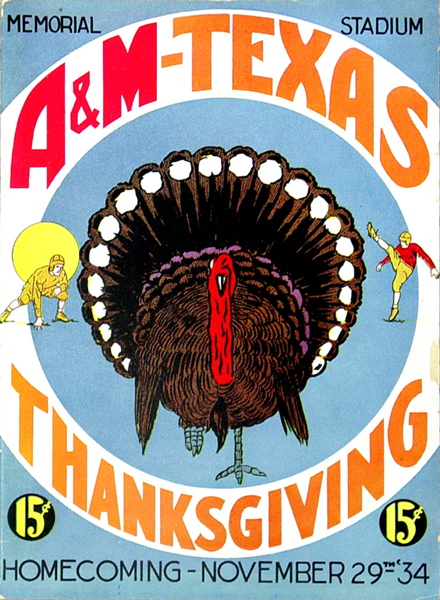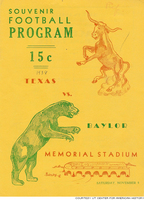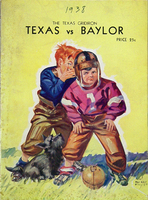1930-1939
Austin fared better than most cities during the Great Depression, as it was home to both the state government and a university that now enrolled more than 4,000 students. Despite the economic hardships in other parts of the country, UT continued to build and grow, adding Gregory Gym in 1930, Anna Hiss Gym in 1931 and dedicating nine new buildings at UT’s 50th birthday anniversary in 1933. Clyde Littlefield continued to coach both the football and track teams through that anniversary year, but resigned from football after the ’33 season when his team finished 4-5-2. It was UT’s first losing season in 40 years of football. Littlefield didn’t leave the university, however, just the gridiron. He continued as UT’s track coach, eventually winning 25 SWC championships in that sport.
Littlefield was replaced by Jack Chevigny of Notre Dame, who worked with Knute Rockne as an assistant and had become famous for scoring the winning touchdown against Army after Rockne's famous "Win one for the Gipper" speech. Though he might have had the right stuff for Notre Dame, Chevigny's three years at Texas resulted in a 13-14-2 record, and he asked the Athletic Council to find a replacement after the 1936 season. The Athletic Council found far more than a replacement in 1937 when they lured Dana X. Bible away from Nebraska with a ten-year guaranteed salary of $15,000 a year and the promise that Bible could be Athletic Director as well as head coach. The salary was about twice what the president of UT made at the time, and it was four times the salary of the governor of the state of Texas! For the next decade, Bible led the Longhorns to a 63-31-3 record, three Southwest Conference championships and the school's first bowl game.
The surviving football programs of the 1930s also tell an interesting tale. The first thing one notices, of course, is the vibrant use of color. Although a few of the surviving early programs were printed on colored paper or used a second color of ink along with the standard black, a revolution in the technology of the graphic arts was underway in the 1930s, which made it less expensive to do full-color printing. The other change, however, was that because colored printing was now less expensive, commercial artists began "franchising" illustrations for program covers that could then be purchased by high schools or colleges who would simply insert their own team names and game dates. The result, of course, was often a dramatic difference in the quality of the new franchised art, versus locally produced covers. The 1934 Thanksgiving cover, for instance, with its bold turkey and appropriate orange and maroon uniform colors was probably produced locally in Austin by a commercial artist with some training in graphic design. The 1936 and 1937 Texas vs. Oklahoma covers, however, were clearly mass-produced and look more like a magazine cover one might find on Saturday Evening Post or similar family magazine in the Thirties. The 1937 cover, in fact, features the artwork of famous commercial artist H. Alonzo "Lon" Keller, whose most memorable work (in addition to the hundreds of program covers he drew for colleges and high schools) is the team logo he designed for the New York Yankees baseball club in 1947; it is still used today.
The most interesting aspects of the Thirties covers is, in fact, the great variety in their quality. P. Hartley's hand-drawn 1938 cover for the program/scorecard for the Baylor game looks out of place next to commercial artist Mac Rae Gillies' "Texas Gridiron" media guide for that same game. Images of small children playing football were especially popular in this Norman Rockwell era, and San Francisco artist Michael Kady specialized in these winsome and popular illustrations for football programs. Hartley's simple cover is also overshadowed by the majestic 1939 Texas A& M cover produced to honor the completion of the San Jacinto Monument to the men who fought for Texas' independence. A&M had right to be proud of the monument-the world's tallest tower at the time-as it was the brainchild of Aggie alumnus Jessie A. Jones, who was then serving as Franklin Roosevelt's Secretary of Commerce. The former "Farmers" could be proud of their 1939 season as well. It was the first time the Aggies were named National Champions.





